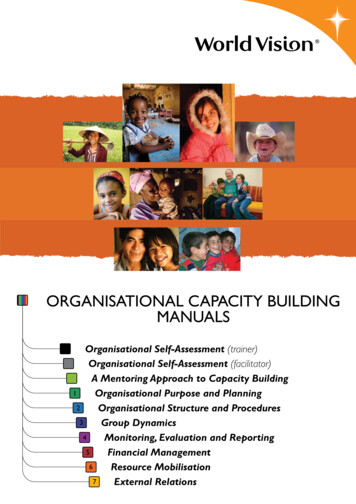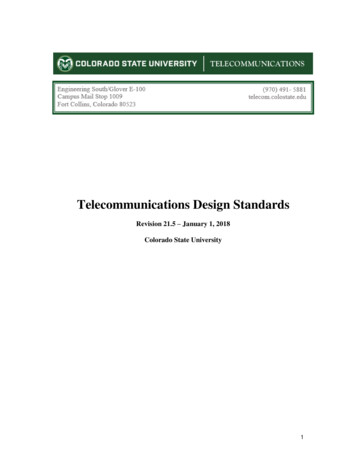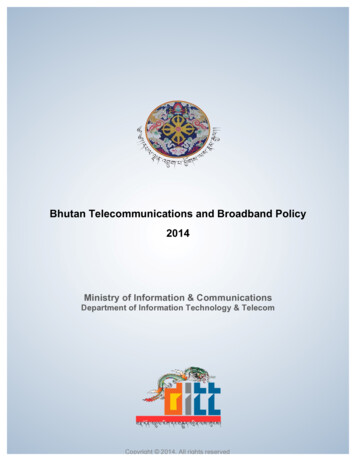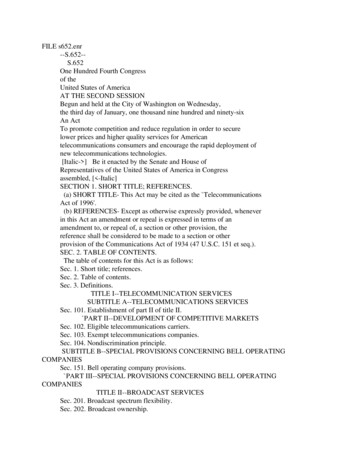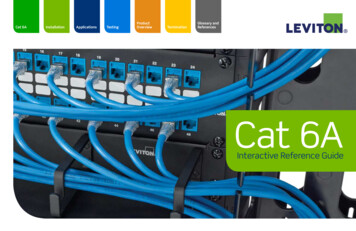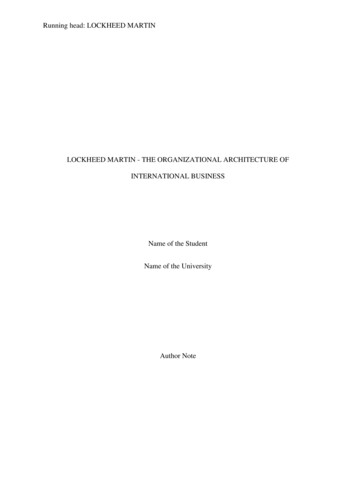
Transcription
Volume 2 Issue 2 December 2010The Organisational Structure of Telecommunications CompaniesCase study: The OTE GroupMadelaine Pepenel”Constantin Brâncoveanu University”of Piteşti, madelaine pepenel@yahoo.comIoana-Iulica Voicu”Constantin Brâncoveanu University” of Piteşti, ii voicucb@yahoo.comAbstract:Transnational corporations today are proving to be an important driver of the world economy. In turn,companies that offer mobile communications services have become important means to build bridgesbetween people and between companies, regardless of their location. To maintain optimal functioning ofthese organizations, a strong and also flexible “backbone” is needed. A transnational company that isimportant to the Balkan region, operating in the telecommunications area, is the OTE SA company, basedin Greece. The company formed together with its subsidiaries the OTE Group. The OTE Group carries outactivities in Romania through the mobile subsidiary Cosmote Romania, which was imposed in our countryas a major mobile any,telecommunicationsservices,mobileJEL classification: A10; E00; F23.1. Introduction:Group structure and organization of OTE Telecommunications CompanyHellenic Telecommunication Organization SA (OTE SA) is a traditional supplier oftelecommunications services in Greece, which forms, together with its subsidiaries, oneof the leading telecommunications companies in South East Europe - OTE Group. Thegroup provides fixed telephony services, broadband Internet, data transmission, leasedlines and mobile services in Greece, Romania, Albania and Bulgaria.OTE Company SA holds 54% of the shares of RomTelecom, the incumbenttelecommunications operator in Romania, providing services through fixed line (voice,broadband Internet, leased lines) and Satellite TV Service, as shown by Figure no. 1below.The OTEGlobe SA operates in the same fixed line telecommunications subsidiary, whichspecializes in the provision of wholesale international telecommunications carriers andlarge multi-site organizations in Southeastern Europe. OTEGlobe operates two highcapacity optical networks, stretching from Greece to Western Europe.96
European Journal of Interdisciplinary StudiesFigure no. 1. OTE Group StructureLandlineMobileOTE SA GreeceOtherAMC AlbaniaZapp %Globul Bulgaria100%70%CosmoteRomania100%30%100%OTE Globe Greece100%OTEestate Greece99%Hellas Sat Greece94%OTESat-Maritel GreeceOtherGermanosSouthEastEuropeSource: OTE S.A., OTE Corporate Presentation, May 2010, p. 5Historically speaking, fixed telephony services formed the nucleus on which OTE Groupwas built. Fixed telephony services in Greece are conducted by the OTE SA company(founded in 1949), which is also the parent of OTE Group. Figure no. 2 presents the mainbrands of fixed-telephony services belonging to OTE Group.Figure no. 2. OTE fixed-line operatorsSource: www.ote.grAn important part of OTE Group's activities is to deliver mobile services. In Greece, theseactivities are undertaken by the company COSMOTE Mobile Telecommunications SA,wholly owned by OTE Group.COSMOTE Greece has expanded itself to provide mobile services through subsidiaries inAlbania (AMC), Bulgaria (Globe) and Romania (and Telemobil SA COSMOTE Romania- Zapp). Cosmote Greece, together with its subsidiaries, stands for the Cosmote group, anOTE Group of companies which carries out mobile operations.The contribution of OTE Group revenue for 2009, according to the industry is shown inthe Figure no. 3, below:97
Volume 2 Issue 2 December 2010Figure no. 3. Contribution revenues in 2009, according to the OTE;36,20%Source: OTE S.A., OTE Annual Report 2009, p. 13In addition to products and services in fixed and mobile operations, OTE Group isinvolved in a number of additional areas through its subsidiaries in Greece, in order toprovide integrated products and services, covering companies and individuals’communications needs.The OTE SA company is among the five largest companies by market capitalization atthe Athens Stock Exchange (ASE). It is also listed on stock exchanges in New York(NYSE) and London (LSE). Initially, the company OTE SA was wholly owned by theGreek state, but in 1996 the state has gradually reduced its stake in OTE's share capital.Following an agreement signed in 2008 on the participation of the German companyDeutsche Telekom to the OTE social capital, Deutsche Telekom owns a 30% stake inOTE SA.Figure no. 4. OTE SA Company ownership structureInstitutionalshareholders inGreece;10,20%Greek 40%Source: OTE S.A., OTE Corporate Presentation, May 2010, p. 5In a period characterized by rapid technological change and a liberalized marketenvironment, the group's parent company OTE, the Hellenic TelecommunicationOrganization SA (OTE SA), seeks to maintain market leadership in Greece andstrengthen its international presence.98
European Journal of Interdisciplinary StudiesTo respond to this strategy, the company OTE SA has adopted an organizational structurethat oversees both fixed line business activities in Greece and all other OTE Groupinternational activities. This structure is based on four dedicated business units ("BusinessUnit") and a Group Corporate Center.The Board of Directors is the company's top administrative body. Its members are electedby the General Assembly of Shareholders, its purpose being to protect the generalinterests of society and ensure its operational efficiency. As part of its responsibilities, theBoard approves the OTE company strategy and takes decisions in establishingsubsidiaries or equity participation in other local or international companies.7The Group’s Chief Executive is the highest executive authority of the company,coordinating all departments and divisions of the company and representing the companyin all operational activities in Greece and abroad, and to all authorities.2. COSMOTE Group – OTE's Mobile Communications DivisionThe Company “COSMOTE Mobile Telecommunications SA” (COSMOTE), registered inAthens - Greece, started its commercial activities in April 1998 in order to provide mobileaccess to all of Greece. COSMOTE is wholly owned by the company HellenicTelecommunications Organization SA (OTE SA), and it has expanded its activities in theBalkan region by successive acquisitions of mobile operators, where the Cosmotebusiness brand and principles were implemented. This is the principle according towhich Cosmote has succeeded to create a group of companies dedicated to mobiletelephony - COSMOTE Group.Figure no. 5. COSMOTE Group Expansion CECIPRUSource: COSMOTE Mobile Telecommunications S.A., Financial statements - parent company,consolidated for the year ended 31 December 2009, p. 147OTE S.A., OTE Corporate Governance Report 2009, p. 699
Volume 2 Issue 2 December 2010In August 2000, Cosmote acquired an 82.5% stake in "Albanian Mobile Communications(AMC), the leading mobile operator in Albania. In July 2005, COSMOTE has completedthe acquisition of 70% of the shares of "COSMOTE Romania SA (formerly known asCosmorom).Another milestone in the development of the group was the acquisition of 100% of globalfirms in Bulgaria. Since 2005, COSMOTE has developed activities in FYROM (FormerYugoslav Republic of Macedonia) by acquiring COSMOFON company, but that wasabandoned in 2009. Another important step was the acquisition in 2006 of the Germanoschain stores, the largest marketing network of products and mobile communicationservices in the region.On December 31st 2009, COSMOTE Group consisted of parent COSMOTE companysubsidiaries also presented in Table no.1. Despite the challenges caused by the financialcrisis, COSMOTE Group continued to record positive results. The COSMOTE Group'scustomer base reached 22 million, by about 14% more than in 2008.In Q4 2009, COSMOTE Group maintained its leadership in the telecommunicationsmarket in Greece, increased its revenue market in Romania and made operationalperformance over the market in countries where it is today.Table no. 1. COSMOTE Group subsidiariesSeveral FieldsCountryOwnership31/12/2009COSMOBULGARIA MOBILE EAD(GLOBUL AD)Mobile telecommunicationsservicesBulgaria100%S.C. COSMOTE ROMANIAN MOBILETELECOMMUNICATIONS SA(COSMOTE ROMANIA SA)Mobile nia100%Mobile ece97%Mobile telecommunicationsservicesAlbaniaCOSMOHOLDING CYPRUS LTDInvestmentCyprus100%GERMANOS SARetail salesGreeceGreece100%Mobile telecommunicationsservicesGreece100%GERMANOS TELECOM ROMANIA SARetail salesRomania100%SUNLIGHT ROMANIA S.R.L. – FILIALARetail salesRomania100%GERMANOS TELECOM BULGARIA ADRetail salesBulgaria100%MOBILBEEP LTDRetail salesGreece100%Overdue accountsGreece100%Company’s DenominationCOSMOHOLDING ROMANIA LTDTELEMOBIL SACOSMOHOLDING ALBANIA AE (CHA)ALBANIAN MOBILE COMMUNICATIONSSh.a (AMC)E-VALUE SAE-VALUE ONE PERSON LTD82.45%Source: COSMOTE Mobile Telecommunications S.A., Financial statements - parent company andconsolidated for the year ended 31 December 2009, p. 14.100
European Journal of Interdisciplinary Studies3. COSMOTE Romania – a Subsidiary of the COSMOTE GroupCOSMOTE Romania, member of COSMOTE Group, was launched on the Romanianmarket in December 2005. Today, COSMOTE Romania is 70% owned by "COSMOTEMobile Telecommunications SA and 30% by Romtelecom, owned themselves by theOTE SA. Cosmote Romania was founded by a fresh Cosmorom mobile operator, mobilecommunications division of Romtelecom. Taken over by Cosmote Greece, Cosmoromcompany went through a restructuring and rebranding process.From the very beginning of its commercial activities, COSMOTE Romania undertook anambitious plan of network expansion and an appropriate strategy to provide qualitymobile services accessible to all. During the five years of working in the local market,COSMOTE Romania has invested over EUR 680 million. Today, COSMOTE Romaniahas a national distribution network, consisting of over 840 COSMOTE, Germanos,Internity, RomTelecom stores as well as several independent dealers2. Throughout 2009,COSMOTE Romania has continued to invest in its network, managed to achieve apopulation coverage of 99.1% and 89.1% geographical coverage.The company's main activity is providing a full range of mobile communications services:postpaid and prepaid services, international calls and roaming, a variety of services suchas voicemail, text messaging, call forwarding, teleconferencing, and also mobile data,communications and COSMOTE agenda: i-mode wireless Internet and fax and dataservice.In April 2010, Cosmote Romania announced the launch of 3G services, providing Internetaccess and high speed mobile broadband national coverage. An important step was theacquisition business development company Telemobil SA (Zapp), completed in October2009. This provides additional growth potential for COSMOTE Romania, as the companywill be able to offer new mobile broadband services via its 3G and CDMA licenses.At the end of the first quarter of 2010, the total number of customers of COSMOTERomania reached 7.2 million, of which 21% are subscribers. Widening the base ofsubscribers particularly for the business sector, it has generated a significant increase inrevenue. The number of prepaid customers also increased, despite tough competition inthis segment. Currently reaching a market share exceeding 23% and having anopportunity to offer 3G services as the result of Zapp’s takeover, Cosmote Romania isfocusing on expanding its presence on mobile internet and corporate segments2.To support the rapid growth of the company, COSMOTE has become one of the mostdynamic employers in the market. In the last two years, COSMOTE has created over 600jobs currently with over 1,100 employees.COSMOTE Romania Company’s activity is coordinated by the parent company inGreece, in order for it to become a part of the group’s strategic plans. The work dedicatedto the mobile communications field noted that "the media and telecommunications sectoris made up of only a limited number of fully independent mobile operators, since, notonly that most such companies have begun life as an alternative fixed line operator, butlately there has been a tendency even from the operators that were working in full (oralmost) in mobile communications [.] to acquire certain assets of fixed lines.88Curwen Peter, Whalley Jason, The Internationalisation of Mobile Telecommunications – StrategicChallenges in a Global Market, Ed. Edward Elgar Publishing Ltd, England, 2008, p. 2101
Volume 2 Issue 2 December 2010The Romania COSMOTE company structure is based on divisions and departments. Eachdivision from the organizational structure coordinates several specific departments.Currently, the subsidiary of COSMOTE Romania is concerned with the successfulcompletion of the organizational integration of Zapp. In this approach, the ExecutiveDirector of COSMOTE Romania has taken over the duties of the President and CEO ofTelemobil (Zapp) and those of the Romania SA Telecom Germanos General Manager.Figure no. 6. The Organizational Structure of COSMOTE SA RomaniaGeneral ManagerDepartmentpt. aintenanceDivisionMarketing& DivisionRetailDivisionPurchase&LogisticsDivisionA areaB areaC umanResourcesDivisionPR & PrivateInstitutionsDivisionSource: Authors’ research4. ConclusionsThe transnational companies’ structure is based on several aspects: size of organization,type of products offered, size of geographical area covered, the level of coordination ofthe business needs. For a business that evolves from a national level to a transnationalone, the organizational structure evolves with the size of the business, encounteringchanges which may reflect the international operations increase in complexity. Thestructure arises from the market approach strategy and from how the company decides tomeet the market needs and requirements: through a local or global policy response. Alongwith adopting a particular organizational structure, a transnational company'smanagement team will decide on a management strategy, covering the balance of powerbetween parent company and subsidiaries, to harmonize the objectives of local interestwith the global interest ones.An important factor often associated with globalization and rapid expansion oftransnational corporations is the ICT (information technology and communications)sector’s strong progress of late. This technological development enables the rapidexchange of information between parent companies and subsidiaries of transnational102
European Journal of Interdisciplinary Studiescorporations and ensures the provision and processing of necessary decision-making. Therapid development of the telecommunications sector was driven by political decisions toeliminate monopoly states in this sector. The telecommunications sector liberalizationpaved the way for private investment in this field. A major target of investment is themobile phone used by both people and companies.An important aspect in analyzing the organization and management of the COSMOTERomania subsidiary is the presence in the ownership of OTE SA of Deutsche Telekom.This proved to be a fairly discreet shareholder. So far the Germans have not made anyradical change in Romania: all top managers - appointed in Athens remained in office norhas the German manager assumed a position of visibility in public companies on the OTElocal market.9 Moreover, OTE's chief executive said that "we must say very clearly thatRomtelecom and Cosmote are direct subsidiaries of OTE and Deutsche Telekom.Deutsche Telekom's involvement is welcome, it is desirable to happen and it will happen,but it will take place only through the Greece parent company"10 However, the Germans’entry into ownership began to be felt. They have created inside COSMOTE andRomTelecom joint working teams, and the financial reports on the market have not onlyAthens as their destination, but also Bonn. There is no doubt that a suitable structurefacilitates the company’s costs minimization, the access to new markets and optimalcommunication of internal information. Wrong decisions in choosing an organizationalstructure may cause the company losses, which in a highly competitive economicenvironment can make the difference between survival and elimination from the market.References:Andersson Ulf, Holm Ulf, Managing the Contemporary Multinational - The Role of Headquarters, EdwardElgar Publishing Ltd, England, 2010.Cullen John B., Parboteeah K. Praveen, International Business - Strategy and the Multinational Company,Routledge - New York, 2010.Curwen Peter, Whalley Jason, The Internationalisation of Mobile Telecommunications – StrategicChallenges in a Global Market, Edward Elgar Publishing Ltd, England, 2008.Dunning John H., Lundan Sarianna M., Multinational Enterprises and the Global Economy, SecondEdition, Edward Elgar Publishing Ltd, England, 2008.Voinea Liviu, Transnational corporations and global capitalism („Corporaţiile transnaţionale şicapitalismul global”), Polirom Publishing House, Jassy, 2007.OTE S.A., OTE Corporate Governance Report 2009.COSMOTE Mobile Telecommunications S.A., Financial statements - parent company and consolidated forthe year ended 31 December 2009.Websites:COSMOTE, www.cosmote.roOTE Group, www.ote.grZiarul Financiar, www.zf.roUNCTAD, www.unctad.org9www.zf.ro, article The Germans say that they have established strong and solid bonds with Romania,through OTE”, 02.05.201010www.zf.ro, article „Deutsche Telekom and OTE: It is too soon to expect drastic changes for Romania?”,22.03.2009103
The Organisational Structure of Telecommunications Companies Case study: The OTE Group . a nd a Group Corporate Center. The Board of Directors is the company's top administrative body. Its members are elected . as voicemail, text messaging, call forwarding, teleconferencing, and also mobile data, communications and COSMOTE agenda: i-mode .


